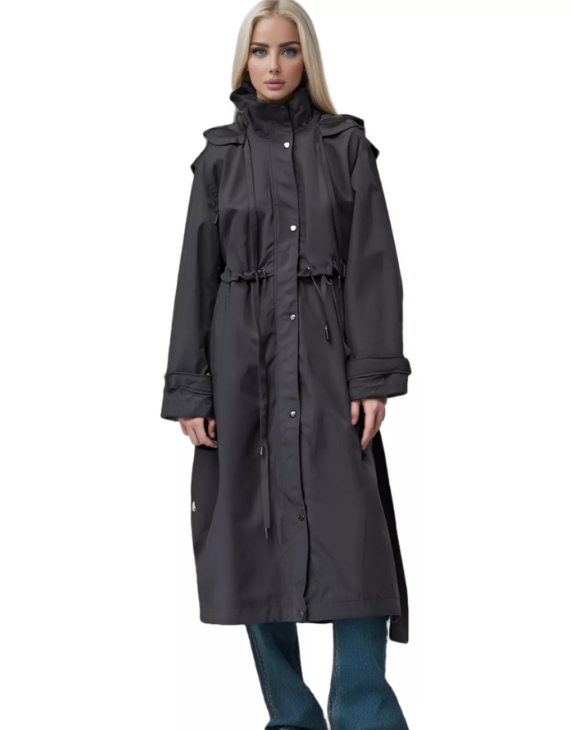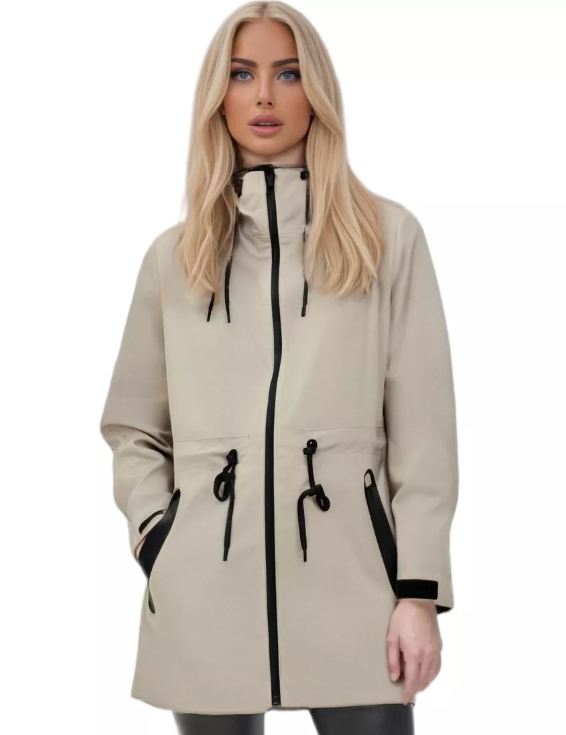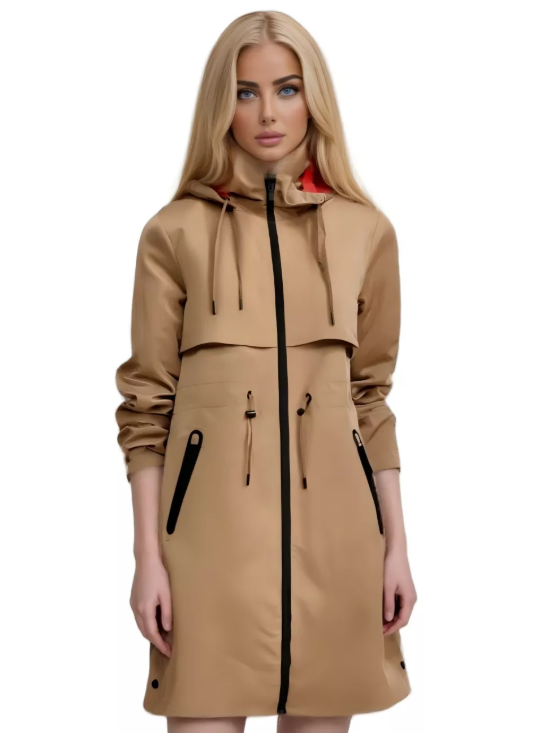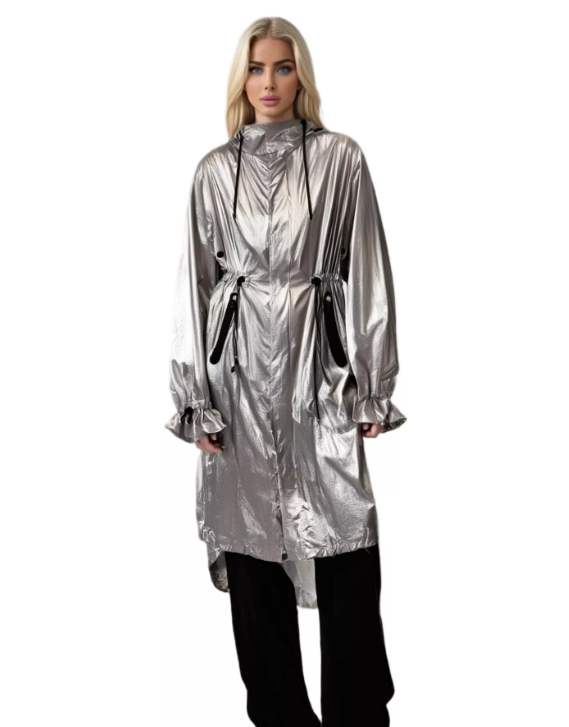Raincoats are essential for staying dry during unexpected downpours, but have you ever wondered what they’re made of? The material of a raincoat plays a crucial role in its performance, durability, and comfort.
In this post, we’ll explore the different materials used in raincoat manufacturing, from lightweight nylon to high-performance Gore-Tex. You’ll learn how to choose the right material based on your climate, activities, and personal preferences.

Key Features of Raincoat Materials
Waterproof vs. Water-Resistant vs. Water-Repellent
These terms often get confused, but they have distinct meanings when it comes to raincoat materials.
· Waterproof: Provides complete protection, blocking all water from entering. Ideal for heavy rain.
· Water-Resistant: Offers moderate protection, suitable for light showers.
· Water-Repellent: Treated fabric that sheds water but isn't fully impermeable. Works well in light drizzle.
Each feature affects how well your raincoat performs, especially during varying weather conditions.
Durability and Comfort Factors
A raincoat should stand the test of time, but comfort is equally important.
· Durability: Materials like Gore-Tex and polyester are known for their long-lasting properties, handling rough conditions.
· Comfort: Soft, flexible fabrics allow for easier movement, making your raincoat more comfortable for daily wear.
Look for a balance of both when choosing a raincoat to ensure it lasts without sacrificing comfort.
Breathability and Flexibility
A good raincoat should keep you dry but also comfortable.
· Breathability: Materials like Gore-Tex allow moisture and sweat to escape, preventing that clammy feeling inside the coat.
· Flexibility: Flexible fabrics help the raincoat move with you, offering better mobility for outdoor activities like hiking or cycling.
Breathability and flexibility can make a big difference in your overall comfort during physical activities in the rain.
Top Materials Used in Raincoat Production
Gore-Tex – The Gold Standard
Gore-Tex is known for its outstanding waterproofing and breathability, making it the go-to material for high-performance raincoats.
· Waterproof: Keeps you dry even in the heaviest rain.
· Breathable: Allows moisture to escape, keeping you comfortable during physical activities.
· Durable: Long-lasting and resistant to wear and tear.
Best for outdoor enthusiasts, Gore-Tex raincoats excel in activities like hiking, skiing, and camping.
Nylon – Lightweight and Versatile
Nylon is a popular choice for those seeking a balance of water resistance and lightweight comfort.
· Affordable: Less expensive compared to other premium materials.
· Lightweight: Easy to wear without feeling weighed down.
· Water-Resistant: Provides moderate protection against light rain.
Ideal for casual wear and commuting, nylon raincoats are perfect for everyday use.

Polyester – Long-Lasting and Affordable
Polyester is known for its durability and resistance to the elements, offering a reliable raincoat option.
· Durable: Resistant to wear and UV damage.
· Affordable: A budget-friendly option without sacrificing quality.
· Resistant to Wrinkles: Maintains a neat look with minimal care.
Polyester raincoats are great for mild outdoor activities or everyday wear, offering solid protection at a lower price.

PVC (Polyvinyl Chloride) – Maximum Waterproofing
PVC is a plastic material known for its total waterproofing, but it lacks breathability.
· Waterproof: Offers complete protection from rain.
· Heavy-Duty: Excellent for industrial or work-related environments.
While not ideal for physical activities, PVC raincoats are the go-to option for extreme waterproofing needs.
EVA (Ethylene Vinyl Acetate) – Eco-Friendly and Lightweight
EVA is gaining popularity for its eco-friendly properties and lightweight feel.
· Non-Toxic: Safe for both people and the environment.
· Biodegradable: A great choice for eco-conscious buyers.
· Lightweight: Easy to wear, even for long periods.
EVA raincoats are perfect for light outdoor activities, offering comfort and environmental benefits.
How to Choose the Right Material for Your Raincoat
Consider Your Climate
The weather in your region plays a key role in selecting the right material.
· Heavy Rain: Gore-Tex is perfect for torrential downpours, keeping you dry and comfortable.
· Milder Weather: Nylon is ideal for light rain or drizzle, offering water resistance without extra bulk.
Choose materials based on how often you encounter rain and the intensity of the weather.
Purpose and Activity
Your raincoat’s intended use impacts the material choice.
· Outdoor Activities: For hiking, camping, or skiing, look for durable materials like Gore-Tex that can withstand harsh conditions.
· Everyday Commuting: If you need something portable and stylish, a lightweight nylon or polyester raincoat will serve you well.
Consider how much protection you need and whether you’ll be moving a lot in it.
Budget and Sustainability
Cost and environmental impact are important factors to consider.
· Cost: Gore-Tex is excellent but more expensive, while materials like nylon and polyester offer great value.
· Eco-Friendly: If sustainability matters, EVA raincoats are a biodegradable option that’s gentle on the planet.
Balance your budget with the material's durability and environmental benefits when making your choice.
Pros and Cons of Common Raincoat Materials
Gore-Tex Pros and Cons
Gore-Tex is a top choice for high-performance raincoats.
· Advantages:
Waterproof: Keeps you dry even in the heaviest rain.
Breathable: Allows sweat to escape, preventing a clammy feeling.
Durable: Long-lasting and resistant to wear.
· Disadvantages:
Expensive: Higher price compared to other materials.
Special Care: Requires proper cleaning and maintenance to maintain performance.
PVC Pros and Cons
PVC is a great option for complete waterproofing.
· Advantages:
Full Waterproofing: Offers complete protection from rain.
Affordable: A budget-friendly option for maximum waterproofing.
· Disadvantages:
Not Breathable: Can feel uncomfortable in warm or humid conditions.
Uncomfortable in Hot Weather: Lacks ventilation, making it less suitable for active use.
Polyester Pros and Cons
Polyester is a durable and affordable material for raincoats.
· Advantages:
Affordable: A great value option for everyday use.
UV-Resistant: Protects against sun exposure and fading.
· Disadvantages:
Less Breathable: Not as breathable as Gore-Tex, which can lead to discomfort in warmer conditions.
Additional Features to Look for in a Raincoat
An adjustable hood and cuffs help customize the fit of your raincoat for better protection.
· Custom Fit: Allows you to tighten or loosen the raincoat, ensuring water and wind stay out.
· Better Coverage: You can adjust the hood to cover your face or neck during heavy rain.

Waterproof Zippers and Sealed Seams
These features add extra layers of protection to keep you dry.
· Waterproof Zippers: Specially designed to prevent water from seeping through the zippers.
· Sealed Seams: Ensures no water can sneak through the stitching, making the raincoat fully waterproof.
Breathable Linings and Ventilation Panels
To stay comfortable during rain, breathability is key.
· Breathable Linings: These materials help wick away sweat and moisture, keeping you dry inside.
· Ventilation Panels: Allow air to flow, reducing heat buildup and preventing discomfort during physical activities.
How to Maintain Your Raincoat’s Waterproofing
Cleaning and Care Tips
Proper cleaning ensures your raincoat's waterproofing lasts longer.
· Use Gentle Detergents: Avoid harsh chemicals, as they can damage the waterproof coating.
· Follow Care Instructions: Always check the manufacturer's guidelines for specific washing methods.
· Wash Gently: Hand wash or use a gentle cycle to preserve the fabric and coating.
Restoring Waterproof Coatings
Over time, waterproof coatings may wear down, but you can restore them.
· Durable Water Repellent (DWR) Sprays: Apply DWR sprays to revive the coating and enhance water resistance.
· Follow Instructions: Be sure to follow the product instructions for best results.
Storing Your Raincoat
Proper storage helps extend your raincoat's lifespan and maintain its functionality.
· Keep It Dry: Always store your raincoat in a cool, dry place to avoid mold growth.
· Avoid Compression: Don’t store it folded or compressed; use a wide hanger to maintain its shape.
· Ensure Full Dryness: Make sure it’s completely dry before storing to prevent odors and fabric degradation.
Conclusion
When choosing a raincoat, consider the material that best fits your needs.
· Gore-Tex is perfect for harsh weather, while Nylon suits lighter conditions.
· Polyester offers a budget-friendly, durable option, and PVC is great for full waterproofing.
Make an informed decision based on your climate, activity level, and budget to ensure comfort and protection.
FAQs
Q: Which material is best for hiking raincoats?
A: Gore-Tex is ideal for hiking raincoats as it offers excellent waterproofing and breathability, ensuring comfort during long outdoor activities.
Q: What’s the most affordable raincoat material?
A: Polyester and PVC are both affordable options. Polyester offers durability and UV resistance, while PVC provides maximum waterproofing at a low cost.
Q: Are breathable raincoats better for long wear?
A: Yes, breathable raincoats, like those made from Gore-Tex, are more comfortable for long wear, preventing sweating and keeping you dry inside.
Q: Can you use a PVC raincoat for everyday wear?
A: PVC raincoats are waterproof and affordable but lack breathability, making them less comfortable for extended wear in hot weather.












